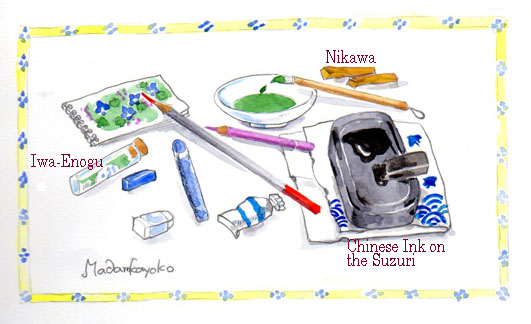I usually paint or draw my pictures or sketches in Japanese traditional pigments, Chinese ink, pencil, color pencil or watercolors. I scarcely use oil paints.
Japanese traditional pigments require gelatin as a medium to bind it to the paper. This gelatin, called “nikawa” in Japanese, also is used in art all over the world including in Chinese ink.
In Europe, artists often used nikawa to make the bases of their works by mixing it with plasters and applying it to wood and other objects instead of using canvases, until oil colors were invented. This method is called “tempera”. Many Renaissance masterpieces are made on tempera, like “The Birth of Venus” and “Primavera” by Sandro Botticelli to name a couple. Nowadays, some artists still intentionally work with tempera for their pieces.
Anyway, nikawa is an ocher-colored solid substance that looks like amber, and consists of a sort of protein that you get after boiling fish or animal bones, cooling the residue and finally drying it out to make it solid. Before the moisture has completely evaporated from nikawa, the substance is tender like jellyfish and you can eat it. This nikawa, we call nikogori, and Japanese izakaya bars often serve nikogori to their customers. It is delicious and healthy because it contains no fat but is high in protein.
To produce Chinese ink, nikawa is mixed with soot that you get after burning pine pitch and kneading them together for a long time, until they form a solid. To draw in Chinese ink, you need to pour a little water on a rock, called suzuri, while rubbing a piece of solid Chinese ink cake on it for over ten minutes, then you can get a wide range of graduation in monochrome.
The general term applied to Japanese traditional pigments is iwa-enogu. Iwa means “rock,” and enogu means “pigment.” This is because ancient Japanese people ground colored rocks to use them for pigments when painting pictures. Nowadays, natural pigments are too expensive for me to paint in, so I use cheaper chemical-made pigments. Painting in iwa-enogu involves soaking nikawa in water in a small bottle for two hours and heating it while it melts, then mixing it with the various pigments.
Chinese ink and Japanese iwa-enogu are both difficult to use, while Western watercolors are easy because they are packed in tubes. Western watercolors are made with Arabic gum.
Despite their inconvenience for painting, for me, Chinese ink and Japanese iwa-enogu feel more powerful than watercolors. For this reason, I usually decide which one to use depending on the kind of work I’m painting.
Each material has its own advantages and disadvantages.
Oil colors are sleek, bright, and easy to use. But it takes a week to dry and it smells bad during the evaporation process. Acrylic resin was invented in the beginning of the 20th century. It looks like oil colors and is easy to use with water, what’s more, it scarcely smells. Recently I use acrylic resin from time to time for my works.
By the way, have you ever wondered where Japanese color names come from? Are there any differences between English and Japanese color names? Both stem from natural things such as flowers and birds, but there are differences in how they are named. For example, deep-purple/pink is called fuchsia in English, and botan-iro, which means “a color like peony petals,” in Japanese. In Japanese, iro means color. Grayish pale pink is called salmon pink in English and toki-iro in Japanese. Toki means “ibis” in Japanese – a bird whose feathers are partially pale pink. Although toki used to be common in rice fields all over Japan, the native Japanese variety is now unfortunately extinct because it was averse to agrichemicals. All tokis in Japan now originate from China.
In addition, many Japanese kids these days seem to use English names when referring to colors. They never say toki-iro instead of pink. I suspect that, like the toki, Japanese color names are also endangered.
My Japanese Blog is here to see click!

